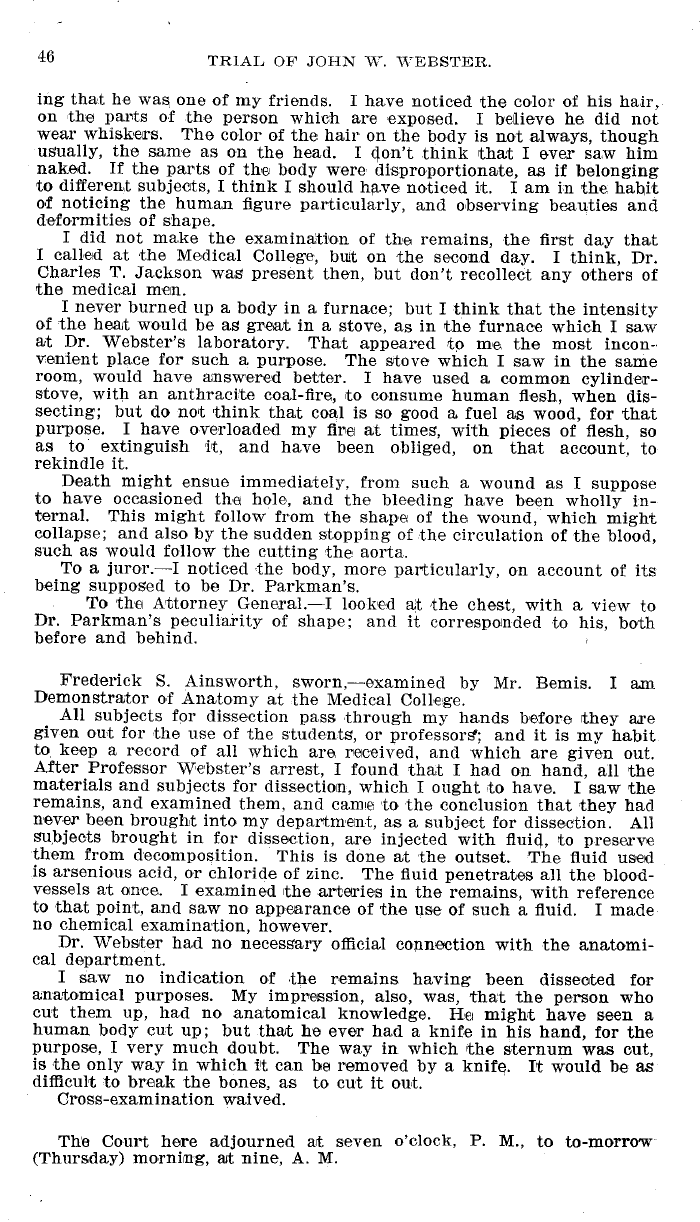|
46 TRIAL OF JOHN W. -WEBSTER.
ing that he was one of my friends. I have noticed the color of his hair,
on the parts of the person which are exposed. I believe he did not
wear whiskers. The color of the hair on the body is not always, though
usually, the same as on the head. I don't think that I ever saw him
naked. If the parts of the) body were disproportionate, as if belonging
to different subjects, I think I should have noticed it. I am in the habit
of noticing the human figure particularly, and observing beauties and
deformities of shape.
I did not make the examination of the remains, the first day that
I called at the Medical College, but on the second day. I think, Dr.
Charles T. Jackson was present then, but don't recollect any others of
the medical mean.
I never burned up a body in a furnace; but I think that the intensity
of the heat would be as great in a stove, as in the furnace which I saw
at Dr. Webster's laboratory. That appeared to me the most incon-
venient place for such a purpose. The stove which I saw in the same
room, would have answered better. I have used a common cylinder-
stove, with an anthracite coal-fire, to consume human flesh, when dis-
secting; but do not think that coal is so good a fuel as wood, for that
purpose. I have overloaded my fire at times, with pieces of flesh, so
as to extinguish it, and have been obliged, on that account, to
rekindle it.
Death might ensue immediately, from such a wound as I suppose
to have occasioned the hole., and the bleeding have been wholly in-
ternal. This might follow from the shape of the wound, which might
collapse; and also by the sudden stopping of the circulation of the blood,
such as would follow the cutting the aorta.
To a juror.-I noticed the body, more particularly, on account of its
being supposed to be Dr. Parkman's.
To the Attorney General.-I looked alt the chest, with a view to
Dr. Parkman's peculiarity of shape; and it corresponded to his, both
before and behind.
Frederick S. Ainsworth, sworn,-examined by Mr. Bemis. I am
Demonstrator of Anatomy at the Medical College.
All subjects for dissection pass through my hands before they axe
given out for the use of the students, or professors'; and it is my habit
to keep a record of all which are received, and which are given out.
After Professor Webster's arrest, I found that I had on hand, all the
materials and subjects for dissection, which I ought to have. I saw the
remains, and examined them, and camie to the conclusion that they had
never been brought into my department, as a subject for dissecction. All
subjects brought in for dissection, are injected with fluid, to preserve
them from decomposition. This is done at the outset. The fluid used
is arsenious acid, or chloride of zinc. The fluid penetrates all the blood-
vessels at once. I examined the arteries in the remains, with reference
to that point, and saw no appearance of the use of such a fluid. I made
no chemical examination, however.
Dr. Webster had no necessary official connection with the anatomi-
cal department.
I saw no indication of the remains having been dissected for
anatomical purposes. My impression, also, was, that the person who
cut them up, had no anatomical knowledge. He might have seen a
human body cut up; but that he ever had a knife in his hand, for the
purpose, I very much doubt. The way in which the sternum was cut,
is the only way in which ft can be removed by a knife. It would be as
difficult to break the bones, as to cut it out.
Cross-examination waived.
The Court here adjourned apt seven o'clock, P. M., to to-morrow
(Thursday) morning, alt nine, A. M.
|

